The way to write a novel these days is to procure a bootleg copy of Word, name your main character Ed Cullen instead of Harry Potter, and plagiarize the last bestselling series. While this isn't a good way to get your name into the literary canon, it's a surefire way to make some easy money and probably secure a movie deal.
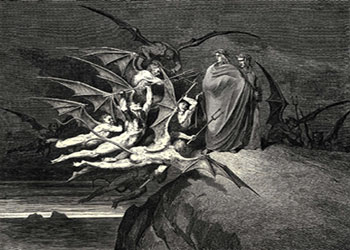 That's not how it was done in the Days of Yore. Back then, writers found patrons to fund them while they wrote, and then took as long as they needed to craft the best possible poem, theological tome, or philosophical text. Partly this was because the pre-modern world had a thing called Hard Work, and partly it was just because everyone took everything more seriously.
That's not how it was done in the Days of Yore. Back then, writers found patrons to fund them while they wrote, and then took as long as they needed to craft the best possible poem, theological tome, or philosophical text. Partly this was because the pre-modern world had a thing called Hard Work, and partly it was just because everyone took everything more seriously.
There was no one who took things more seriously than Durante degli Alighieri, better known as Dante, the Italian poet who bridged the gap between the Middle Ages and the early years of the Italian Renaissance. He wrote what is considered one of the greatest works of literature of all time, the three-part epic poem The Divine Comedy.
What's the proof that he was so serious? No more proof is needed than The Divine Comedy itself, particularly the way Mr. Alighieri chose to write it. Instead of shallow characters mashed-up with a boring, shallow plot, Dante decided to explain the depths of Christian theology concerning the afterlife in a series of literal and metaphorical vignettes.
To do this as comprehensively as possible, he wrote with the four modes of interpretation always in mind. The four modes of interpretation were a set of hermeneutic (interpretive) rules for understanding what a particular written work meant, and it was a thoroughly Medieval system.
The first mode was the literal, according to which things meant exactly what they seemed to mean on the surface. The second mode was the typological, in which events in the narrative mirrored or symbolized events in the Bible. The third was the moral mode (which means exactly what it sounds like), and the fourth was the anagogical mode.
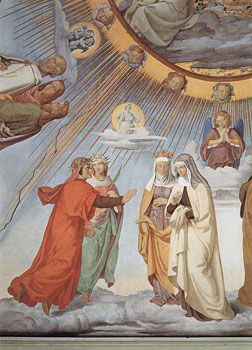 In this final mode, things that are visible represent things that are invisible; in other words, if a physical object or person is present in the story, they actually represent (at least on the anagogical level) an eternal reality, such as the horror of hell, the hope of the resurrection, or the nature of heaven.
In this final mode, things that are visible represent things that are invisible; in other words, if a physical object or person is present in the story, they actually represent (at least on the anagogical level) an eternal reality, such as the horror of hell, the hope of the resurrection, or the nature of heaven.
At this point, most readers will simply shrug and conclude that it's easier to figure out what Ed Cullen is thinking than to understand The Divine Comedy, so why go for the dead Italian guy? Well, if you'd read the whole series you'd realize ol' Eddy is really just a dead Italian, too, but that's not the point.
The point is that reading a book like The Divine Comedy, despite its difficulty and the boredom it has been known to induce, is actually worth your time. That such care went into its writing should be proof enough that there's at least something valuable in its pages, but there's also another reason that's even more compelling.
If Dante's masterpiece was only interesting or curious, we wouldn't be able to recommend it very highly. Great books aren't made by appealing to our baser instincts, but by transcending them and pointing us beyond our self-importance to a truth or truths that exist through all time and for all people. The Divine Comedy is such a book.
Consider again the four modes of interpretation. Developed by Medieval theologians, they're designed not only to help readers understand the sometimes bizarre imagery in the Bible, but also to act as a theological compass, pointing behind, in front of, above, and below through its treatment of history, prophecy, God, and man.
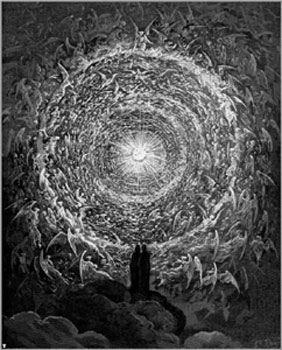 That Dante could write an entire epic poem rooted in such deep concepts is impressive enough. That he could write such a work and make it interesting is almost unbelievable. And if you don't think this book is interesting, who isn't interested in the sign hanging above the entrance of Hell? or who Satan has in his mouth? or what happens to the prideful?
That Dante could write an entire epic poem rooted in such deep concepts is impressive enough. That he could write such a work and make it interesting is almost unbelievable. And if you don't think this book is interesting, who isn't interested in the sign hanging above the entrance of Hell? or who Satan has in his mouth? or what happens to the prideful?
Don't think that all of this is supposed to exactly reflect Dante's beliefs. When he talks about the torments of the wicked and the pleasures of the blessed, he isn't writing theology, he's writing literature. But he's writing literature that is theologically informed, and expresses truths that Christians everywhere can and should embrace.
No one today (and maybe no one in Dante's day, either) will pick up on all the references, or be able to accurately read the entire work according to the four modes of interpretation. Even so, there's enough here to intrigue even the most reluctant reader, and to foster deep thought as few works can. For the bestseller crowd, there's even a few vampires.
Review by C. Hollis Crossman
C. Hollis Crossman used to be a child. Now he's a husband and father who loves church, good food, and weird stuff. He might be a mythical creature, but he's definitely not a centaur. Read more of his reviews
here.
ABOUT THE TRANSLATIONS

Click here to view an exclusive comparison chart featuring seven translations of The Divine Comedy.
NOTE: Since creating this page, we have heard of the Robert & Jean Hollander and Clive James translations and hope to add a comparison of those in the near future. We've added comparisons for the the Allan Mandelbaum and the Robin Kirkpatrick translations but still need to write short summaries of their approaches. (December 2022)
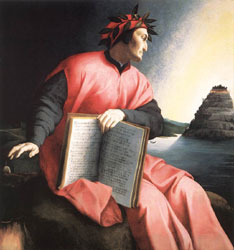 Dante invented terza rima, a poetic form in which the end-word of the second line in one tercet rhymes with the end-words of the first and second lines in the next tercet. Sound complicated? An easy way to understand this is to use the alphabet. A terza rima poem would look like this:
Dante invented terza rima, a poetic form in which the end-word of the second line in one tercet rhymes with the end-words of the first and second lines in the next tercet. Sound complicated? An easy way to understand this is to use the alphabet. A terza rima poem would look like this:
ABA
BCB
CDC
As you can tell from looking at the comparison chart, translators differ quite a bit in terms of structure.
We carry Mark Musa's 1971 Divine Comedy as a set and a one-volume softcover edition called The Portable Dante. It includes a lengthy introduction detailing Dante's life and work, easy-to-read footnotes on nearly every page, and La Vita Nuova in its entirety. Musa eschewed both terza rima and free verse in favor of five-beat lines. He strongly believed that rhythms are more important than rhymes, and he doesn't hesitate to criticize those who came before him: "My main reason for avoiding rhyme has been the results achieved by all those who have used rhyme in translating the Divine Comedy: they have shown that the price paid was disastrously high. I believe that all those who have offered rhymed translations of Dante could have produced far better poems if they had not used rhyme." The translator, Musa remarks, "should have listened more carefully to Dante's voice before he let us hear his own."
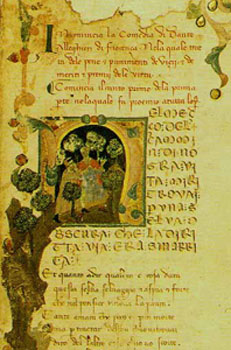 In contrast to Musa, Dorothy Sayers remains faithful to Dante's original structure. With a break after every third line, Sayers' translation is a concise and lively rendering which gives us the opportunity to experience the same poetic form Dante's first readers did. Her translation has been often praised by teachers and students who appreciate her insightful comments and footnotes throughout. Matthew Turnbull of Alexandria Tutorials requires his students to read the Divine Comedy in its entirety, and believes that compared to Musa's additional material, Sayer's commentary is "more comprehensive, more communicative of the medieval time and place and worldview that Dante inhabited, and vastly more engaging." While not illustrated, this translation is accompanied by various diagrams and pictures scattered throughout the notes. We currently do not carry a one-volume edition of this translation. You can purchase the books individually (Hell, Purgatory, and Paradise) or buy the set.
In contrast to Musa, Dorothy Sayers remains faithful to Dante's original structure. With a break after every third line, Sayers' translation is a concise and lively rendering which gives us the opportunity to experience the same poetic form Dante's first readers did. Her translation has been often praised by teachers and students who appreciate her insightful comments and footnotes throughout. Matthew Turnbull of Alexandria Tutorials requires his students to read the Divine Comedy in its entirety, and believes that compared to Musa's additional material, Sayer's commentary is "more comprehensive, more communicative of the medieval time and place and worldview that Dante inhabited, and vastly more engaging." While not illustrated, this translation is accompanied by various diagrams and pictures scattered throughout the notes. We currently do not carry a one-volume edition of this translation. You can purchase the books individually (Hell, Purgatory, and Paradise) or buy the set.
Anthony Esolen's Italian/English bilingual editions forego terza rima in favor of English iambic pentameter: "Dante's linguistic range rivals that of any poet besides Shakespeare. No translator can match it; I hope only that the ruggedness and muscularity of his diction will still appear, with some regularity, in these English verses." We carry Esolen's Divine Comedy in three parts, each with about 10 illustrations by Gustave Doré, the French engraver (see the engravings above; you can find many more online). Unlike Musa's fact-packed biographical introduction, Esolen's three introductions to the Inferno, Purgatory and Paradise are well-crafted philosophical essays exploring the deeper meanings and cultural significance of Dante's masterwork. The text layout of this edition is elegant and easy-to-read.
Another translation we carry is John Ciardi's. When starting the translation process, Ciardi attempted terza rima, but failed: "There are approximately 4,500 lines in each third of the Divine Comedy. One must find 1,500 triple-rhymes to rend each third into terza rima, and English has no such rhyme-resources. Mechanically, it can be done, but not in anything approximating spoken American English. I could see through what wrestling agonies I had to put my own efforts in order to force the language around to that third rhyme..." Ciardi experimented with blank verse, but struggled with line length. Assonantal rhyming, ballad stanzas—none worked. Finally Ciardi tried what he calls a "dummy terza rima." He kept the three line unit, but rhymed only the first and third rhymes. The font size is a bit larger in this particular edition, and there's plenty of room in the margins for note-taking. Like Sayers, Ciardi chose to put his notes at the end of each canto, instead of at the bottom of each page. Included is an introduction by Archibald T. MacAllister and a "How To Read Dante" preface written by Ciardi. Memoria Press uses this translation in their Divine Comedy Study Guide.
One translation rarely read today but quite popular at the beginning of the 19th century is that of Henry Francis Cary. The one-volume edition published by Wordsworth Classics includes the Inferno, Purgatorio, and Paradiso all rendered in blank verse without any attempt to reproduce Dante's triple-rhyme. Instead, the Anglican clergyman focused on accuracy and faithfulness to the original, and the resulting translation is very formal but still highly readable. Cary's translation is the one that made The Divine Comedy popular to English poets like Keats, Blake, and others. This edition includes an introduction, chronology, bibliography, and other academic helps.
Also, check out Peter Leithart's Ascent to Love, a wonderful resource for both serious students and casual readers. Dante is one of those authors who offers readers so much, and Leithart's rich yet plain spoken philosophical observations will help you get more of out the Comedy.
Did you find this review helpful?